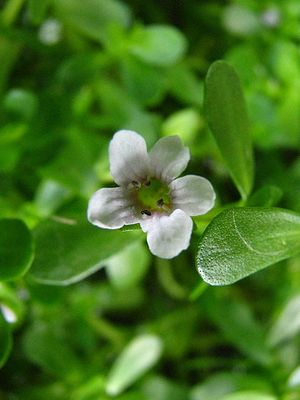Note: This is a project under development. The articles on this wiki are just being initiated and broadly incomplete. You can Help creating new pages.
Bacopa monnieri - Brahmi
Bacopa Monnieri is a non-aromatic herb. Its ability to grow in water makes it a popular aquarium plant. It can even grow in slightly brackish conditions.The whole herb is used medicinally in India in a variety of ways. Bacopa is a genus of 70–100 aquatic plants belonging to the family Plantaginaceae.
Contents
[hide]- 1 Uses
- 2 Parts Used
- 3 Chemical Composition
- 4 Common names
- 5 Properties
- 6 Habit
- 7 Identification
- 8 List of Ayurvedic medicine in which the herb is used
- 9 Where to get the saplings
- 10 Mode of Propagation
- 11 How to plant/cultivate
- 12 Season to grow
- 13 Required Ecosystem/Climate
- 14 Kind of soil needed
- 15 Commonly seen growing in areas
- 16 Photo Gallery
- 17 References
- 18 External Links
Uses
Epilepsy, Asthma, Ulcers, Tumors, Gastroenteritis, Ascites, Enlarged spleen, Anaemia, Inflammation, Promote intellect, Memory enhancer, Increase life span, Rejuvinative.
Parts Used
Chemical Composition
Brahmi contains the alkaloids brahmine, herpestine. It contains saponins namely bacosides A and B. It also contains betulic acid, stigmasterol, monnierin and hersaponin. Bacosides A and B on hydrolysis gives triterpenoid aglycone bacogenins A and B respectively.[1]
Common names
| Language | Common name |
|---|---|
| Kannada | ಬ್ರಾಹ್ಮಿ Brahmi, ಕಿರು ಬ್ರಾಹ್ಮಿ Kiru brahmi |
| Hindi | Baam |
| Malayalam | Brahmi |
| Tamil | Neer brahmi, Pirami |
| Telugu | Sambrani aku |
| Marathi | Brahmi, Jalabrahmi |
| Gujarathi | Baam, Jalanevari |
| Punjabi | NA |
| Kashmiri | NA |
| Sanskrit | Brahmi, Tiktalonika |
| English | Indian pennywort, Moneywort |
Properties
Reference: Dravya - Substance, Rasa - Taste, Guna - Qualities, Veerya - Potency, Vipaka - Post-digesion effect, Karma - Pharmacological activity, Prabhava - Therepeutics.
Dravya
Rasa
Tikta (Bitter), Kashaya (Astringent)
Guna
Laghu (Light)
Veerya
Sheet (cold)
Vipaka
Madhura (Sweet)
Karma
Prabhava
Habit
Identification
Leaf
| Kind | Shape | Feature |
|---|---|---|
| Small | Oval | Leaves that are succulent and relatively thick, Brahmi leaves grow alternately on the soft hairy stem |
Flower
| Type | Size | Color and composition | Stamen | More information |
|---|---|---|---|---|
| Unisexual | White-purplish | Five petals | Brahmi flowers bloom in most months of the year. Flowering throughout the year |
Fruit
| Type | Size | Mass | Appearance | Seeds | More information |
|---|---|---|---|---|---|
| Oval | Brahmi fruit is oval and sharp at apex with hooked hairs | Fruitig throughout the year |
Other features
List of Ayurvedic medicine in which the herb is used
Tiktaka Grita, Datri Tailam, Brahmi Grita, Rajata Loha Rasayanam, Ratnagiri Rasa, Lokanatha rasa, Saarasvataarishta, Meghanath Tailam.[4]
Where to get the saplings
Mode of Propagation
How to plant/cultivate
The plant is propagated by soft herbaceous cuttings. For mass propagation, whole plant is cut into small divisions and planted directly in the sunken beds. About 62,500 nos. of cuttings required for planting one hectare area.[5]
Season to grow
It prefers part to full sun and It prefers Summer season.[6]
Required Ecosystem/Climate
It is found at altitudes up to 1300 m. Near-neutral, clayey loam to clayey soils are best suited for the growth of Bacopa monnieri. In North India, it can grow in a wide range of temperatures (15–40 oC) and soil pH (5–7.5).
Kind of soil needed
The plant occurs in a variety of soil types if the habitat provides wet and semi-shade conditions.
Commonly seen growing in areas
Moist and wet places, Irrigated fields, Borders of water, Bank of channels.
Photo Gallery
References
- Jump up ↑ Morphology
- Jump up ↑ Common names
- Jump up ↑ Brahmi Herbal Medicine
- Jump up ↑ "Karnataka Medicinal Plants Volume - 2" by Dr.M. R. Gurudeva, Page No.428, Published by Divyachandra Prakashana, #45, Paapannana Tota, 1st Main road, Basaveshwara Nagara, Bengaluru.
- Jump up ↑ Cultivation details
- Jump up ↑ Bacopa monnier on vikaspedia.in
External Links
- Ayurvedic Herbs known to be helpful to treat Epilepsy
- Ayurvedic Herbs known to be helpful to treat Asthma
- Ayurvedic Herbs known to be helpful to treat Ulcers
- Ayurvedic Herbs known to be helpful to treat Tumors
- Ayurvedic Herbs known to be helpful to treat Gastroenteritis
- Ayurvedic Herbs known to be helpful to treat Ascites
- Ayurvedic Herbs known to be helpful to treat Enlarged spleen
- Ayurvedic Herbs known to be helpful to treat Anaemia
- Ayurvedic Herbs known to be helpful to treat Inflammation
- Ayurvedic Herbs known to be helpful to treat Promote intellect
- Ayurvedic Herbs known to be helpful to treat Memory enhancer
- Ayurvedic Herbs known to be helpful to treat Increase life span
- Ayurvedic Herbs known to be helpful to treat Rejuvinative
- Herbs with Roots used in medicine
- Herbs with Stem used in medicine
- Herbs with Leaves used in medicine
- Herbs with common name in Kannada
- Herbs with common name in Hindi
- Herbs with common name in Malayalam
- Herbs with common name in Tamil
- Herbs with common name in Telugu
- Herbs with common name in Marathi
- Herbs with common name in Gujarathi
- Herbs with common name in Sanskrit
- Herbs with common name in English
- Habit - Herb
- Index of Plants which can be propagated by Seeds
- Index of Plants which can be propagated by Cuttings
- Herbs that are commonly seen in the region of Moist and wet places
- Herbs that are commonly seen in the region of Irrigated fields
- Herbs that are commonly seen in the region of Borders of water
- Herbs that are commonly seen in the region of Bank of channels
- Herbs
- Plantaginaceae
- Ayurvedic herbs that don't have seed photos







